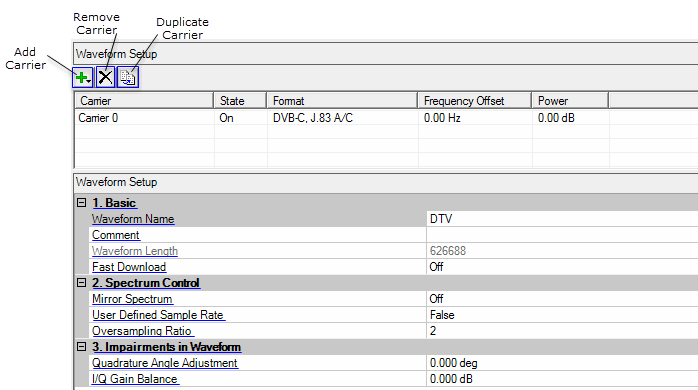 box to expand the waveform property tables and access those parameters.
box to expand the waveform property tables and access those parameters.Clicking in the
![]() tree view
displays the waveform attributes settings table in the node view of the
main window. Click the plus
tree view
displays the waveform attributes settings table in the node view of the
main window. Click the plus  box to expand the waveform property tables and access those parameters.
box to expand the waveform property tables and access those parameters.

Enter an alpha-numeric waveform file name, up to 22 characters in length.
The name can include spaces and some special characters: _ $ & # + - [ ]. You can enter a name with more than 22 characters, but when you click outside of the cell, the software truncates the name to 22 characters.
Enter an alpha-numeric comment up to 32 characters in length. The comment resides in the file header and can include spaces and special characters.
View the generated waveform length (number of points). You cannot edit this cell.
When this parameter is set to be On, the file downloading speed will increase and the export rate will be accelerated as well. It will also reduce the size of temporary file.
This fast download is only effective with only one carrier.
Choice: ON | OFF
Default: OFF
Double-click or use the drop-down menu to swap the I and Q waveforms. This parameter is used during the correction operation to account for low side upconversion between the signal generator and the spectrum analyzer.
Sets whether to use a user defined sample rate as ARB sample clock.
When the User Defined Sample Rate is set to True, Oversampling Ratio is hidden and Sample Rate is shown. When set to False, Sample Rate is hidden and Oversampling Ratio is shown.
Sets the sample rate used as ARB sample clock. This is available only when User Defined Sample Rate is true.
The value (number of points) is automatically determined based on the .
For example, considering is 696320 and ratio is 1, when ratio changed to 2, then becomes 696320*2 = 1392640.
Range: -90.000 to 90.000 degrees
Set the baseband quadrature phase angle, in degrees.
Enter a value to adjust the Q phase angle. When the quadrature angle is zero, the phase angle between the I and Q vectors is 90 degrees. Positive angle adjustment increases the angle from 90 degrees while negative angle adjustment decreases the angle from 90 degrees.
Range: -10.000 to 10.000 dB
Set the baseband quadrature gain balance, in dB. Enter a gain ratio, by which I gain exceeds Q gain.
For example, if you enter a value of 1 dB, the I signal will have 1 dB more amplitude than the Q signal. Use the gain balance to remove imperfections in I and Q, or introduce calibrated impairments.